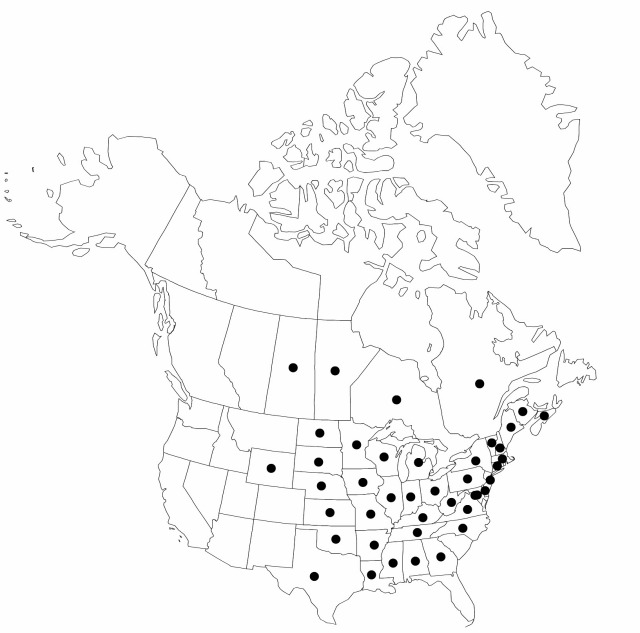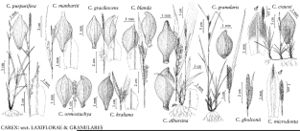Carex granularis
Sp. Pl. 4(1): 279. 1805.
Rhizomes short or inconspicuous. Culms in dense tufts, 13–70(–100) cm. Leaves not green, usually glaucous, cauline blades 2–27 cm × 1.2–5.3 mm. Inflorescnecs: peduncle of terminal spike 0.1–3.5 cm; bracts (middle and distal ones) overtopping spikes; ligule of proximal bract (2–)3–17.5(–26) mm; longest bract blade (per plant) of distal lateral spike 4.1–15.8 cm. Proximal spikes usually arising from distal 1/2 of culms, 6–27(–32) × 3–6 mm. Terminal spike 6–35(–43) mm, shorter than to barely exceeding and overlapping distal lateral spike. Pistillate scales ovate or ovateoblong, 1.4–2.5(–2.9) × 0.8–1.4 mm. Staminate scales with apex acute to acuminate or cuspidate. Anthers 1.6–2.9 mm. Perigynia olive to yellowish green or at age yellowish brown, elliptic- or oblong-ovoid to obovoid, 2.2–3.1(–3.7) × 1.2–1.8(–2) mm, 1.4–2.2(–2.4) times as long as thick; beak 0.1–0.3 mm, orifice nearly entire. Achenes 1.8–2.3 × 1–1.4 mm. 2n = 36, 38, 40, 42.
Phenology: Fruiting late spring–early summer (late Apr–Jul).
Habitat: Low, open ground, meadows, fens, glades, or shores, ditches, moist woods, and bottomland swamps, especially along borders, clearings, streams, trails, usually in clayey or marly soils, frequently weedy in limestone districts
Elevation: 0–700 m
Distribution

Man., N.B., N.S., Ont., Que., Sask., Ala., Ark., Conn., Del., D.C., Ga., Ill., Ind., Iowa, Kans., Ky., La., Maine, Md., Mass., Mich., Minn., Miss., Mo., Nebr., N.H., N.J., N.Y., N.C., N.Dak., Ohio, Okla., Pa., S.Dak., Tenn., Tex., Vt., Va., W.Va., Wis., Wyo.
Discussion
Carex granularis is widely distributed and common across the eastern half of the United States and southeastern Canada, but not on the Coastal Plain or in the high Appalachians. It varies not only in the dimensions and ultimate overall shape of the perigynia but also in less tangible features, such as texture, color, and amount of red speckling on the perigynia, prominence of perigynia veins, and papillosity of achene surface. One phase distinguished by the smaller, slightly less inflated, more ellipsoid perigynia with more pointed apices and finer veins has often been treated as C. haleana or C. shriveri; it intergrades rather freely with typical C. granularis. Because of the subtlety of the distinctions, the intergradation in morphology, and the difficulties presented by specimens in immature stages or distorted during preparation, we maintain C. granularis as a single variable species without infraspecific taxa. An apparent hybrid between C. granularis and C. flaccosperma Dewey or C. glaucodea Tuckerman ex Olney is known from one locality in Arkansas.
Selected References
None.
